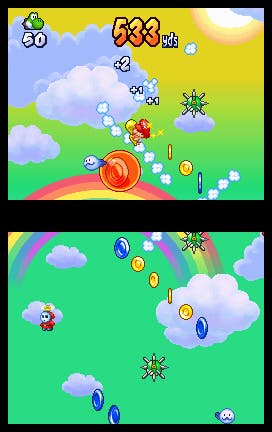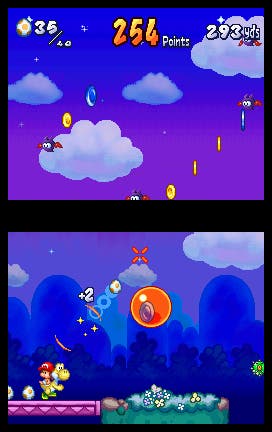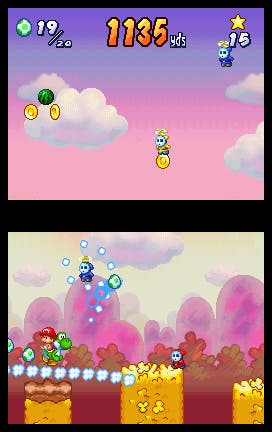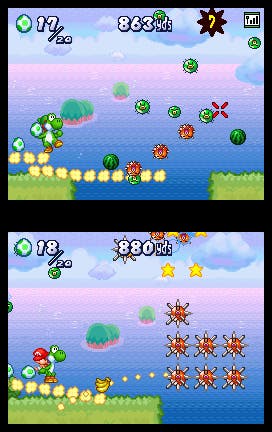Yoshi's Touch & Go
Never likely to send you to cloud nine.
Yoshi's Touch & Go isn't really worth buying at its current price. I know that's a bit of a downer to come in on, but the key point I want to make about is that it's easy to confuse why it isn't worth buying at its current price.
It's about preconceptions. Yoshi's Touch & Go looks like a platform game, with an audiovisual make-up comparable to Yoshi's Island or Super Mario World, but it only really has one actual level, even if it is split into two distinctive parts. And there aren't too many people I know who would pay the best part of £25 for a 2D platformer with one level.
But to mark it down on that basis would be unfair, because you soon realise it isn't really a platformer at all; it's a high scores game, similar in a sense to webgames like this one, which involve getting as far as possible on a linear, forced-scrolling path without coming unstuck even once, and then banking the distance as points.

The idea behind the first part of the level is to guide Baby Mario down to earth. He's floating at a consistent pace under three balloons, which represent the three hits you can take, and your objective is to draw lines of clouds on the touch-screen that steer him away from spiky obstacles and fluttering enemies and in the direction of coins.
When you land, Mario ends up on Yoshi's back, and the left-to-right part begins, wherein one hit kills and the objective is to get as far as possible by drawing clouds, again, to help Yoshi make it over pits, past enemies with simple movement routines and without being struck by any projectiles or anything else. Helpfully, if you die - one hit! - in this section, you can choose to restart from the point that Mario lands without losing your points total from the first section.
You can do a few other things in both sections to help things along. In both the floating and riding sections you can draw small circles around coins and certain enemies, at which point they become bubbles with coins in that you can drag into the path of the falling Mario in the first section and right onto Yoshi in the second, or use to brush clouds, coins and other things around the screen.
You can also blow on the microphone to get your lines of clouds to disappear - which means it's almost impossible to play on the windy London underground, for those of you following our adventures in that department - if you foul up and need to avoid the game playing out the way you've specified. In the Yoshi-riding section you can also tap the screen to have Yoshi fire an egg in that direction - including onto the top screen where coins, enemies and so on reside. Your total of eggs, as fans of Yoshi's exploits might imagine, can be topped up again by tracking down and swallowing fruit in your path.

You can also tap Yoshi himself to make him jump, and tap him again in flight to have him flutter along, double-jump-style, for a bit more air-time. It's actually possible to keep this up indefinitely, although the design of the levels and the level of acceleration in his descent when you mis-time it or let it go means it's never really practical to do this.
And that's basically it. It's a game that's played exclusively with the stylus, and it has one very specific goal: keep going as long as possible. The variety comes from the randomised environments, transitional sections that involve trying to fire your egg projectiles so they bounce round mazy cave complexes on the upper screen and accumulate extra coins, and several different game modes that change the nature of the pressure the game's exerting.
The randomised environments mix in several core types of location with differing characteristics - one may be windswept (so you have to be on your guard to avoid having clouds blown out from under you), another may have monkeys gliding somewhat worryingly up and down thick tree trunks, and there are several others.
The different game modes, meanwhile, involve trying to get as far as possible (Marathon), trying to score as many points as possible by shooting stuff and collecting coins (Score Attack), and a pair of unlockable modes that play on the speed element. You accelerate in both by firing at enemies, collecting things, and so on. Time Attack sees Mario in the clutches of some nasties who must be tracked down and shot down, while Challenge (which seems like it ought to be the one bearing the "Time Attack" name, to be honest) is a race to keep topping up a countdown by taking advantage of bonuses and coins and killing your foes.

Naturally, the further you get in all of these, the more things the game throws at you. Enemies start to require multiple egg-shots to kill (or evasion, if you're low on eggs) and swoop up and down so they're tougher to nail with eggs, start to throw things at you which have to be swatted with a tap of the stylus (as well as a chuck of an egg to actually kill them), and other typical platform difficulty curve tricks.
So then. There's not much to it. But that's not why I'm marking it down. While you could happily argue the case for specific levels that you knock down one by one, rather than this randomisation approach, I'm not convinced that would actually improve the game's worth. Power-up possibilities are limited - although you can make Mario into an invincible high-speed Baby Of Death, which is entertaining - and the only obvious way to keep taking things in a new direction enough to justify that would be to betray the core principles and branch off into some other genre.
It's possible that doing so could make the game last you longer, but then it wouldn't have that compulsive edge to it and would probably feel quite lethargic - particularly given the sluggish pace Yoshi and Mario both move along at. And I don't much feel like scoring it lower because it isn't doesn't become a story-driven role-playing game involving a quest to save the world from a monstrous evil that killed some villagers where Yoshi lived or something halfway through.
But tucked in amongst the weary wittering above lies the real problem in scoring it highly: it isn't really that compulsive anyway. It feels harsh to say it, but the actual idea just isn't that brilliant. It's a nice technical achievement and intelligently pieced together, but it lacks the spark and, more importantly, the precision frenzy of high score games that are more obviously bound to the "puzzle" genre. Yes, like Zoo Keeper.

You can't play it particularly manically. If you do, you tend to draw things in the wrong place or foul other things up. And, though it's not a huge issue, it's actually rather difficult to judge the angle of your shots to the upper DS screen - much as it is in Pac-Pix with that's game's arrow-firing mechanism, come to think of it - because the physical distance between the two screens and the slight angle of the top one muddies your judgement of the transition.
Perhaps someone figured that out during the design process, because although there's plenty of fun to be had here - even in the incredibly basic single-pak multiplayer mode, which involves shooting everything in sight in order to accelerate your way to 1,000 yards quicker than your opponent - it never becomes the sort of high-score game you fall in love with. It makes you smile, but it never makes you gasp, or feel like rushing off to tell your friends about it. It's a comfortable game, and not much more.
Ultimately, Yoshi's Touch & Go looks like it's asking a difficult question, but it never really does because the core concept - whilst interesting, different and certainly as well executed as it can be - never quite hits the level of compulsiveness and excitement that other high-score games like Meteos and Zoo Keeper and, to a certain extent, the Mario 64 DS mini-games have already hit. It'll be well worth checking out when it hits £15, but until then it's Yoshi's Touch & Go.

